Pumping Station Desing - Second Edition by Robert L. Sanks, George Tchobahoglous, Garr M. Jones
Подождите немного. Документ загружается.

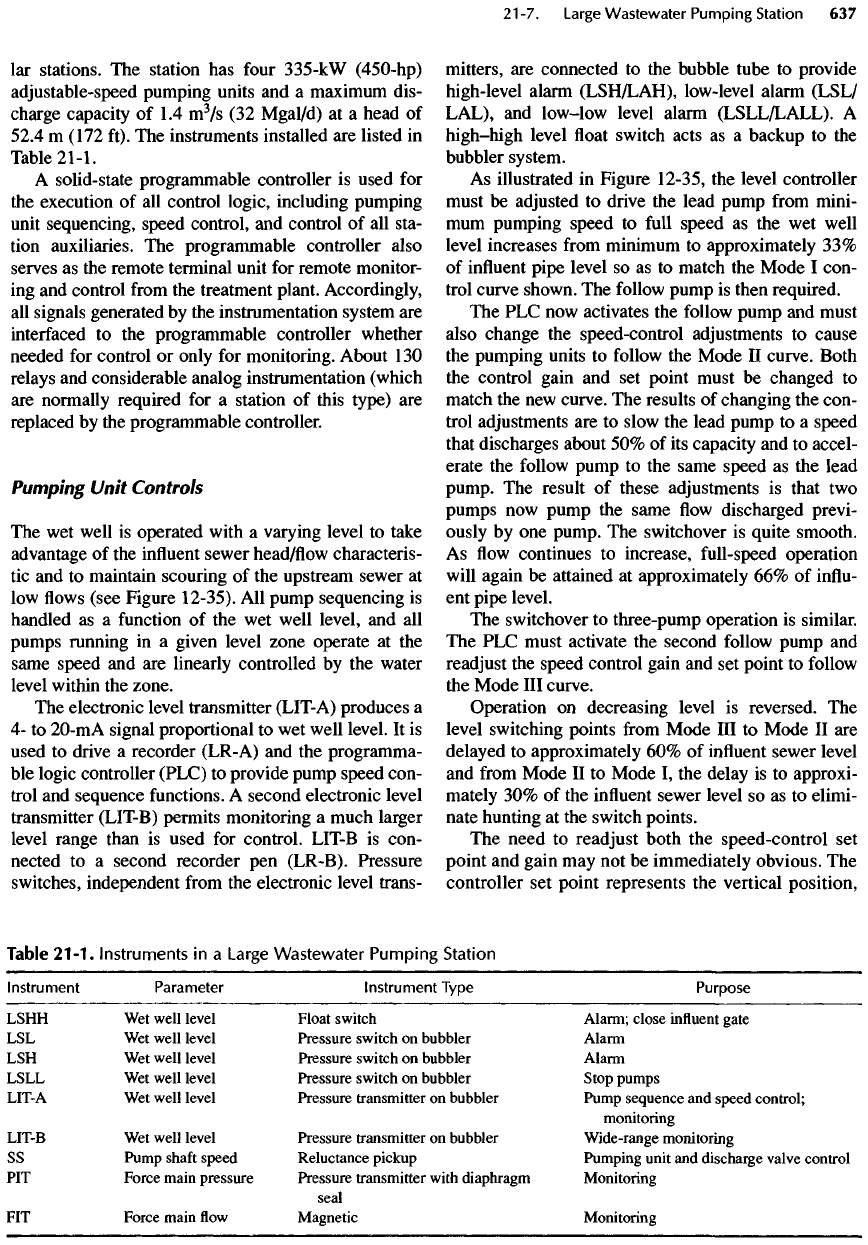
lar
stations.
The
station
has
four
335-kW
(450-hp)
adjustable-speed pumping units
and a
maximum
dis-
charge capacity
of 1.4
m
3
/s
(32
Mgal/d)
at a
head
of
52.4
m
(172
ft).
The
instruments installed
are
listed
in
Table
21-1.
A
solid-state programmable controller
is
used
for
the
execution
of all
control logic, including pumping
unit
sequencing,
speed
control,
and
control
of all
sta-
tion
auxiliaries.
The
programmable controller also
serves
as the
remote terminal unit
for
remote monitor-
ing
and
control
from
the
treatment plant. Accordingly,
all
signals generated
by the
instrumentation system
are
interfaced
to the
programmable controller whether
needed
for
control
or
only
for
monitoring. About
130
relays
and
considerable analog instrumentation (which
are
normally required
for a
station
of
this type)
are
replaced
by the
programmable controller.
Pumping Unit Controls
The wet
well
is
operated with
a
varying level
to
take
advantage
of the
influent
sewer
head/flow
characteris-
tic and to
maintain scouring
of the
upstream sewer
at
low
flows
(see
Figure 12-35).
All
pump sequencing
is
handled
as a
function
of the wet
well level,
and all
pumps
running
in a
given level zone operate
at the
same
speed
and are
linearly controlled
by the
water
level within
the
zone.
The
electronic
level transmitter (LIT-A)
produces
a
4- to
20-mA
signal proportional
to wet
well level.
It is
used
to
drive
a
recorder (LR-A)
and the
programma-
ble
logic controller
(PLC)
to
provide pump
speed
con-
trol
and
sequence
functions.
A
second electronic level
transmitter
(LIT-B) permits monitoring
a
much larger
level range than
is
used
for
control. LIT-B
is
con-
nected
to a
second recorder
pen
(LR-B). Pressure
switches, independent
from
the
electronic level trans-
mitters,
are
connected
to the
bubble tube
to
provide
high-level alarm
(LSH/LAH),
low-level alarm
(LSL/
LAL),
and
low-low
level alarm
(LSLL/LALL).
A
high-high
level
float
switch acts
as a
backup
to the
bubbler system.
As
illustrated
in
Figure
12-35,
the
level controller
must
be
adjusted
to
drive
the
lead pump
from
mini-
mum
pumping
speed
to
full
speed
as the wet
well
level increases
from
minimum
to
approximately
33%
of
influent
pipe level
so as to
match
the
Mode
I
con-
trol curve shown.
The
follow
pump
is
then required.
The PLC now
activates
the
follow pump
and
must
also change
the
speed-control adjustments
to
cause
the
pumping units
to
follow
the
Mode
II
curve. Both
the
control gain
and set
point must
be
changed
to
match
the new
curve.
The
results
of
changing
the
con-
trol
adjustments
are to
slow
the
lead pump
to a
speed
that discharges about
50% of its
capacity
and to
accel-
erate
the
follow
pump
to the
same
speed
as the
lead
pump.
The
result
of
these adjustments
is
that
two
pumps
now
pump
the
same
flow
discharged previ-
ously
by one
pump.
The
switchover
is
quite smooth.
As
flow
continues
to
increase, full-speed operation
will
again
be
attained
at
approximately
66% of
influ-
ent
pipe level.
The
switchover
to
three-pump operation
is
similar.
The PLC
must activate
the
second
follow
pump
and
readjust
the
speed control gain
and set
point
to
follow
the
Mode
III
curve.
Operation
on
decreasing
level
is
reversed.
The
level switching points
from
Mode
HI
to
Mode
II are
delayed
to
approximately
60% of
influent
sewer level
and
from
Mode
II to
Mode
I, the
delay
is to
approxi-
mately
30% of the
influent
sewer level
so as to
elimi-
nate hunting
at the
switch points.
The
need
to
readjust both
the
speed-control
set
point
and
gain
may not be
immediately obvious.
The
controller
set
point represents
the
vertical position,
Table 21-1.
Instruments
in a
Large
Wastewater
Pumping
Station
Instrument
Parameter
Instrument
Type Purpose
LSHH
Wet
well level Float switch Alarm;
close
influent
gate
LSL Wet
well level Pressure switch
on
bubbler Alarm
LSH
Wet
well level Pressure switch
on
bubbler Alarm
LSLL
Wet
well level Pressure switch
on
bubbler Stop pumps
LIT-A
Wet
well level Pressure transmitter
on
bubbler Pump sequence
and
speed control;
monitoring
LIT-B
Wet
well level Pressure transmitter
on
bubbler Wide-range monitoring
SS
Pump
shaft
speed Reluctance pickup Pumping unit
and
discharge valve control
PIT
Force main pressure Pressure transmitter with
diaphragm
Monitoring
seal
FIT
Force
main
flow
Magnetic Monitoring
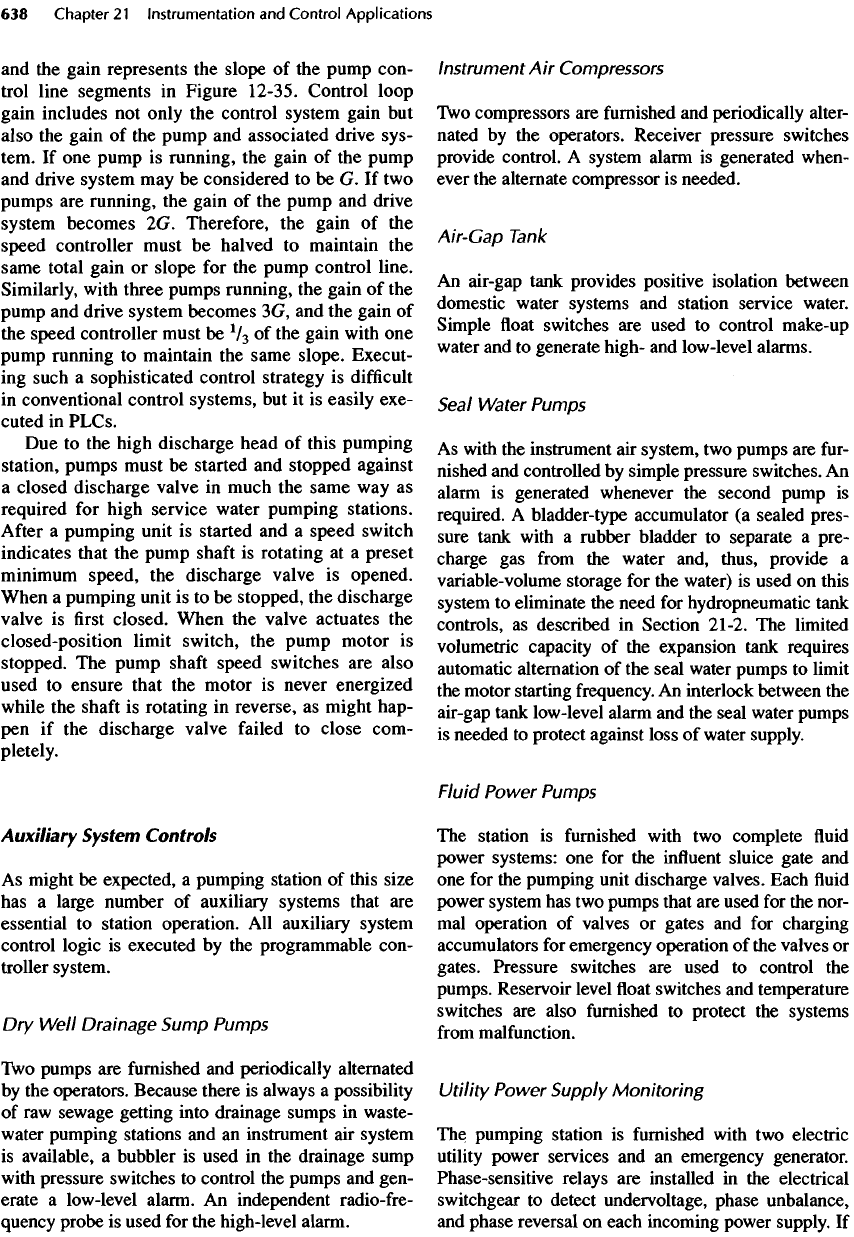
and
the
gain represents
the
slope
of the
pump con-
trol line segments
in
Figure
12-35.
Control
loop
gain includes
not
only
the
control system gain
but
also
the
gain
of the
pump
and
associated drive sys-
tem.
If one
pump
is
running,
the
gain
of the
pump
and
drive system
may be
considered
to be G. If two
pumps
are
running,
the
gain
of the
pump
and
drive
system
becomes
2G.
Therefore,
the
gain
of the
speed controller must
be
halved
to
maintain
the
same total gain
or
slope
for the
pump control line.
Similarly,
with three pumps running,
the
gain
of the
pump
and
drive system becomes
3G, and the
gain
of
the
speed controller must
be
l
/
3
of the
gain with
one
pump
running
to
maintain
the
same
slope.
Execut-
ing
such
a
sophisticated control strategy
is
difficult
in
conventional control systems,
but it is
easily exe-
cuted
in
PLCs.
Due to the
high discharge head
of
this pumping
station, pumps must
be
started
and
stopped against
a
closed
discharge valve
in
much
the
same
way as
required
for
high service water pumping stations.
After
a
pumping unit
is
started
and a
speed switch
indicates that
the
pump
shaft
is
rotating
at a
preset
minimum
speed,
the
discharge valve
is
opened.
When
a
pumping unit
is to be
stopped,
the
discharge
valve
is first
closed.
When
the
valve actuates
the
closed-position limit switch,
the
pump motor
is
stopped.
The
pump
shaft
speed switches
are
also
used
to
ensure that
the
motor
is
never energized
while
the
shaft
is
rotating
in
reverse,
as
might hap-
pen if the
discharge valve failed
to
close com-
pletely.
Auxiliary System Controls
As
might
be
expected,
a
pumping station
of
this size
has
a
large number
of
auxiliary systems that
are
essential
to
station operation.
All
auxiliary system
control logic
is
executed
by the
programmable con-
troller system.
Dry
Well Drainage Sump Pumps
Two
pumps
are
furnished
and
periodically alternated
by
the
operators. Because there
is
always
a
possibility
of
raw
sewage getting into drainage sumps
in
waste-
water
pumping stations
and an
instrument
air
system
is
available,
a
bubbler
is
used
in the
drainage sump
with
pressure switches
to
control
the
pumps
and
gen-
erate
a
low-level alarm.
An
independent radio-fre-
quency
probe
is
used
for the
high-level alarm.
Instrument
Air
Compressors
Two
compressors
are
furnished
and
periodically alter-
nated
by the
operators. Receiver pressure switches
provide control.
A
system alarm
is
generated when-
ever
the
alternate compressor
is
needed.
Air-Gap
Tank
An
air-gap tank provides positive isolation between
domestic water systems
and
station service water.
Simple
float
switches
are
used
to
control make-up
water
and to
generate high-
and
low-level alarms.
Seal
Water
Pumps
As
with
the
instrument
air
system,
two
pumps
are
fur-
nished
and
controlled
by
simple pressure switches.
An
alarm
is
generated whenever
the
second pump
is
required.
A
bladder-type accumulator
(a
sealed pres-
sure
tank with
a
rubber bladder
to
separate
a
pre-
charge
gas
from
the
water and, thus, provide
a
variable-volume
storage
for the
water)
is
used
on
this
system
to
eliminate
the
need
for
hydropneumatic
tank
controls,
as
described
in
Section 21-2.
The
limited
volumetric capacity
of the
expansion tank requires
automatic alternation
of the
seal water pumps
to
limit
the
motor starting frequency.
An
interlock between
the
air-gap tank low-level alarm
and the
seal
water pumps
is
needed
to
protect against
loss
of
water supply.
Fluid
Power Pumps
The
station
is
furnished
with
two
complete
fluid
power systems:
one for the
influent
sluice gate
and
one for the
pumping unit discharge valves. Each
fluid
power system
has two
pumps that
are
used
for the
nor-
mal
operation
of
valves
or
gates
and for
charging
accumulators
for
emergency operation
of the
valves
or
gates. Pressure switches
are
used
to
control
the
pumps.
Reservoir level
float
switches
and
temperature
switches
are
also
furnished
to
protect
the
systems
from
malfunction.
Utility
Power Supply Monitoring
The
pumping station
is
furnished with
two
electric
utility
power services
and an
emergency generator.
Phase-sensitive relays
are
installed
in the
electrical
switchgear
to
detect
undervoltage,
phase unbalance,
and
phase reversal
on
each incoming power supply.
If
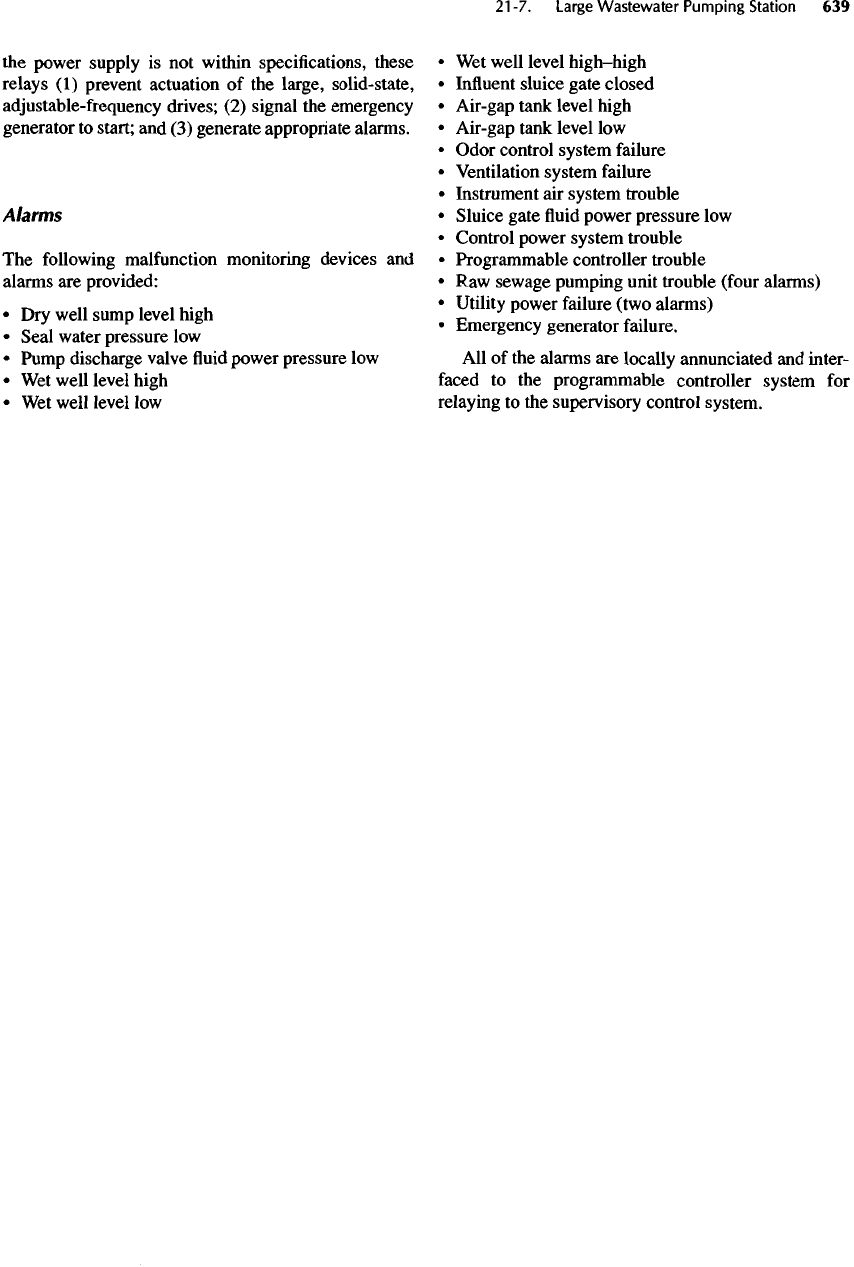
the
power supply
is not
within specifications, these
relays
(1)
prevent actuation
of the
large,
solid-state,
adjustable-frequency
drives;
(2)
signal
the
emergency
generator
to
start;
and (3)
generate appropriate alarms.
Alarms
The
following
malfunction
monitoring devices
and
alarms
are
provided:
• Dry
well sump level high
•
Seal water pressure
low
•
Pump discharge valve
fluid
power pressure
low
• Wet
well level high
• Wet
well level
low
• Wet
well level
high-high
•
Influent
sluice
gate
closed
•
Air-gap tank level high
•
Air-gap tank level
low
•
Odor control system
failure
•
Ventilation system
failure
•
Instrument
air
system trouble
•
Sluice gate
fluid
power pressure
low
•
Control power system trouble
•
Programmable controller trouble
• Raw
sewage pumping unit trouble
(four
alarms)
•
Utility power
failure
(two alarms)
•
Emergency generator failure.
All
of the
alarms
are
locally annunciated
and
inter-
faced
to the
programmable controller system
for
relaying
to the
supervisory control system.
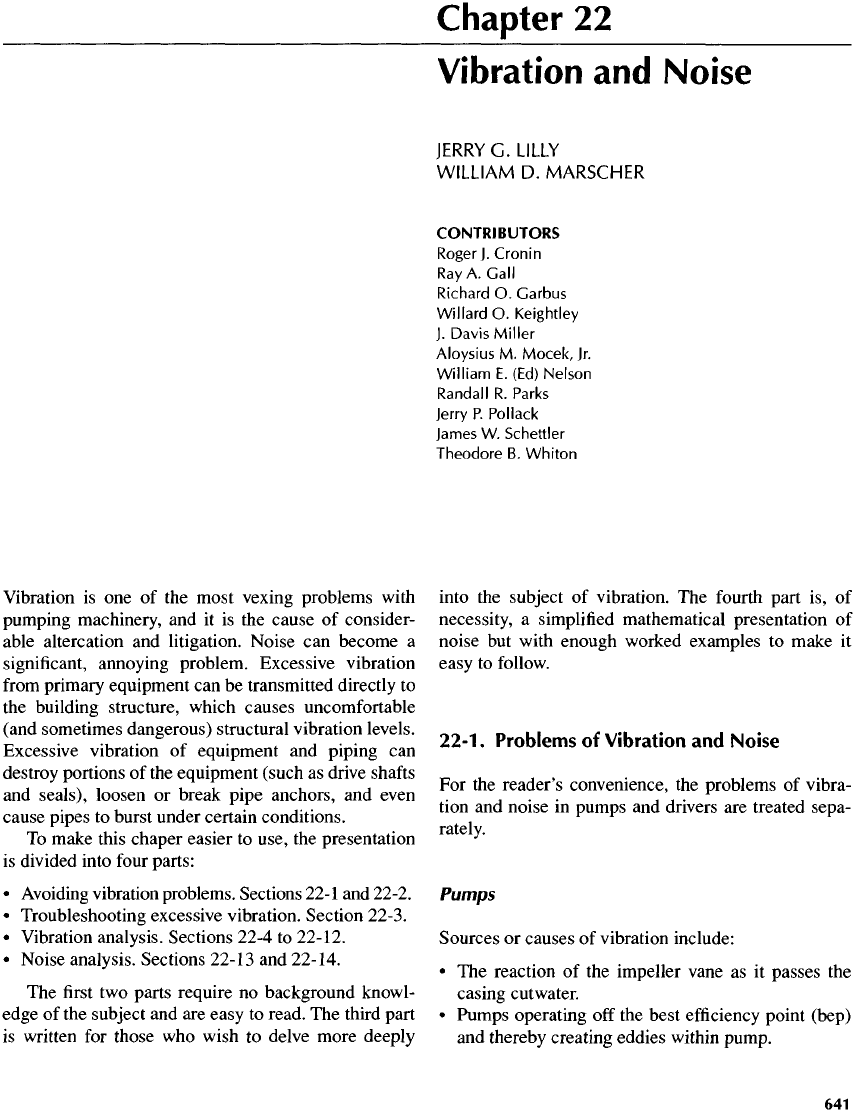
Vibration
is one of the
most vexing problems with
pumping
machinery,
and it is the
cause
of
consider-
able altercation
and
litigation. Noise
can
become
a
significant,
annoying problem. Excessive vibration
from
primary equipment
can be
transmitted directly
to
the
building structure, which causes uncomfortable
(and
sometimes dangerous) structural vibration levels.
Excessive vibration
of
equipment
and
piping
can
destroy
portions
of the
equipment (such
as
drive
shafts
and
seals), loosen
or
break pipe anchors,
and
even
cause pipes
to
burst under certain conditions.
To
make this chaper easier
to
use,
the
presentation
is
divided into
four
parts:
•
Avoiding vibration problems. Sections
22-1
and
22-2.
•
Troubleshooting excessive vibration. Section 22-3.
•
Vibration analysis. Sections 22-4
to
22-12.
•
Noise analysis. Sections 22-13
and
22-14.
The first two
parts require
no
background knowl-
edge
of the
subject
and are
easy
to
read.
The
third part
is
written
for
those
who
wish
to
delve more deeply
Chapter
22
Vibration
and
Noise
JERRYG.
LILLY
WILLIAM
D.
MARSCHER
CONTRIBUTORS
Roger
J.
Cronin
Ray
A.
Call
Richard
O.
Garbus
Willard
O.
Keightiey
J.
Davis
Miller
Aloysius
M.
Mocek,
Jr.
William
E.
(Ed)
Nelson
Randall
R.
Parks
Jerry
P.
Pollack
James
W.
Schettler
Theodore
B.
Whiton
into
the
subject
of
vibration.
The
fourth
part
is, of
necessity,
a
simplified
mathematical presentation
of
noise
but
with enough worked examples
to
make
it
easy
to
follow.
22-1
,
Problems
of
Vibration
and
Noise
For the
reader's
convenience,
the
problems
of
vibra-
tion
and
noise
in
pumps
and
drivers
are
treated sepa-
rately.
Pumps
Sources
or
causes
of
vibration include:
• The
reaction
of the
impeller vane
as it
passes
the
casing cutwater.
•
Pumps operating
off the
best
efficiency
point (bep)
and
thereby creating eddies within pump.

•
Eddies
created
by
water
flowing
through
bends,
valves,
and
other obstructions.
• In
every rotating (e.g., motor)
or
reciprocating (e.g.,
engine) machine, some imbalance
and
shaft
mis-
alignment
always exists.
•
Resonance.
If the
natural
frequency
of the
machine
or
system
is
nearly equal
to the
frequency
of
excita-
tion, however small,
the
resulting vibration
can
become destructive.
Much
of
this chapter
is
devoted
to the
problems
of
lateral
or
translational vibrations, where
the
vibrating
element
actually moves back
and
forth.
Rotating
shafts
may
vibrate
in
both translational and/or tor-
sional modes.
In the
torsional mode,
the
centerline
of
the
shaft
may not
physically move
in
space,
but the
shaft
does rotate
at
slightly
different
instantaneous
rotational
speeds with
different
phases
at
various
points along
the
length
of the
shaft,
which causes
an
oscillating torque. This torsional (twisting) vibration
of
the
shaft
can
develop stresses high enough
to
cause
the
shaft
to
fail
without
any
audible
or
visible warning
signs prior
to the
failure.
The
subtle
character
of
tor-
sional vibration makes
it all the
worse.
The
impact
of a new
pumping station
on
environ-
mental noise levels
in the
community should
be
evalu-
ated prior
to final
site selection, because noise
adversely
affects
residential property values, causes
sleep interference
and
general annoyance,
and may
lead
to
legal action against
the
owner
of the
plant.
Building
codes
often
include noise level limits
at
property
lines. Noise problems
are
most likely
to
occur
when facilities
are
located within
300 m
(1000
ft) of a
residential neighborhood.
To
protect
the
owner
from
legal challenges should
a
subsequent
complaint
develop into
a
court case, documentation
of
environmental
noise levels
by a
qualified
acoustical
consultant
prior
to the
start
of
construction
in
these
instances
is
vital.
All
too
often,
nothing whatever
is
done
to
reduce
the
noise level within
the
pumping station. Excessively
high noise levels here
can
impair speech intelligibility
and
cause temporary
or
even permanent hearing loss
to
operating
personnel exposed over extended periods
of
time.
It is
usually
impractical
to
enclose
a
noisy
machine
in a
sound-absorbing housing, partly because
of
the
need
to
service
the
machine
and
partly because
such measures
are
relatively
ineffective.
Common
practice, therefore,
is to
enclose
all the
noisy machin-
ery
within thick concrete walls
and
ceilings. Requiring
workers
to
wear
ear
protection
and
designing
for
reduced maintenance time
and
worker occupancy
is
helpful.
The
noise level
in the
reverberation
field can
be
reduced
by
acoustical treatment (see
"Indoor
Sound
Propagation"
in
Section
22-13).
Although
the
noise
level cannot
be
reduced
by
much more than
6 to 8
decibels, this reduction
is
often
enough
to
permit con-
versation
and
substantially increase
the
level
of
com-
fort.
At
1996 prices,
the
cost
of
acoustical treatment
varies
from
$40-1
30/m
2
($4-12/ft
2
).
Drivers
Sometimes electric motors
are the
cause
of
excessive
noise
or
vibration. Vibration tends
to
have unusually
high
spikes
at one
and/or
two
times
the
line
frequency
(60
and/or
120
Hz).
If
there
is a
broken rotor
bar or
bad
stator winding,
a
high-pitched noise (and accom-
panying
vibration acceleration)
is
often
evident
at the
"slot
pass"
frequency
(about
100
times running
speed).
In
motors driven
by AF
controllers (particu-
larly
the
older models), strong vibration pulses
are
evident even
for
healthy motors
at 6x,
12x,
18x,
and
sometimes
24x the
frequency
with which
the
control-
ler
feeds
the
motor
at any
given speed. These
frequen-
cies seldom cause dynamic
or
structural resonances
of
any
significance. However, these harmonics
can
sometimes excite
linked-rotor
system torsional critical
speeds
that
are
difficult
to
track down with standard
vibration equipment that cannot directly sense tor-
sional oscillations, even
if
shaft
stresses
are
becoming
excessive.
If
shaft
failures
are
occurring
at the
shaft
shoulder near
the
pump
impeller
or
coupling hub, this
situation
should
be
investigated.
Engines
If
the
driver
is an
internal combustion engine,
the
pri-
mary
driving frequencies (besides
1
times
and 2
times
running
speed
and the
pump vane passing
frequency)
are the
cylinder stroke
frequency
(i.e.,
the
number
of
cylinders times
the
engine speed)
and its first ten
har-
monics.
For
most engines,
the
second harmonic
(i.e.,
2
times engine speed times number
of
cylinders)
is the
strongest,
and no
natural frequency
of the
engine-sup-
port
floor
structure
or the
engine-gear-pump train
should
be
allowed
to
exist anywhere
in the
typical
operating speed range. Resonances
of the
other
first
ten
harmonics cannot, however,
be
ruled out,
and
they
should
be
investigated
if
there
is
excessive noise
or
vibration
in
such installations.
Offset
or
right angle
gear boxes
can
also
be a
torsional excitation source
at
the
gear mesh frequency (number
of
gear teeth times
running
speed).
Gear
mesh
excitations
can
also cause
gear tooth damage and/or excessive noise
due to
axial
resonances
of the
drive
shafts,
particularly
if the
drive
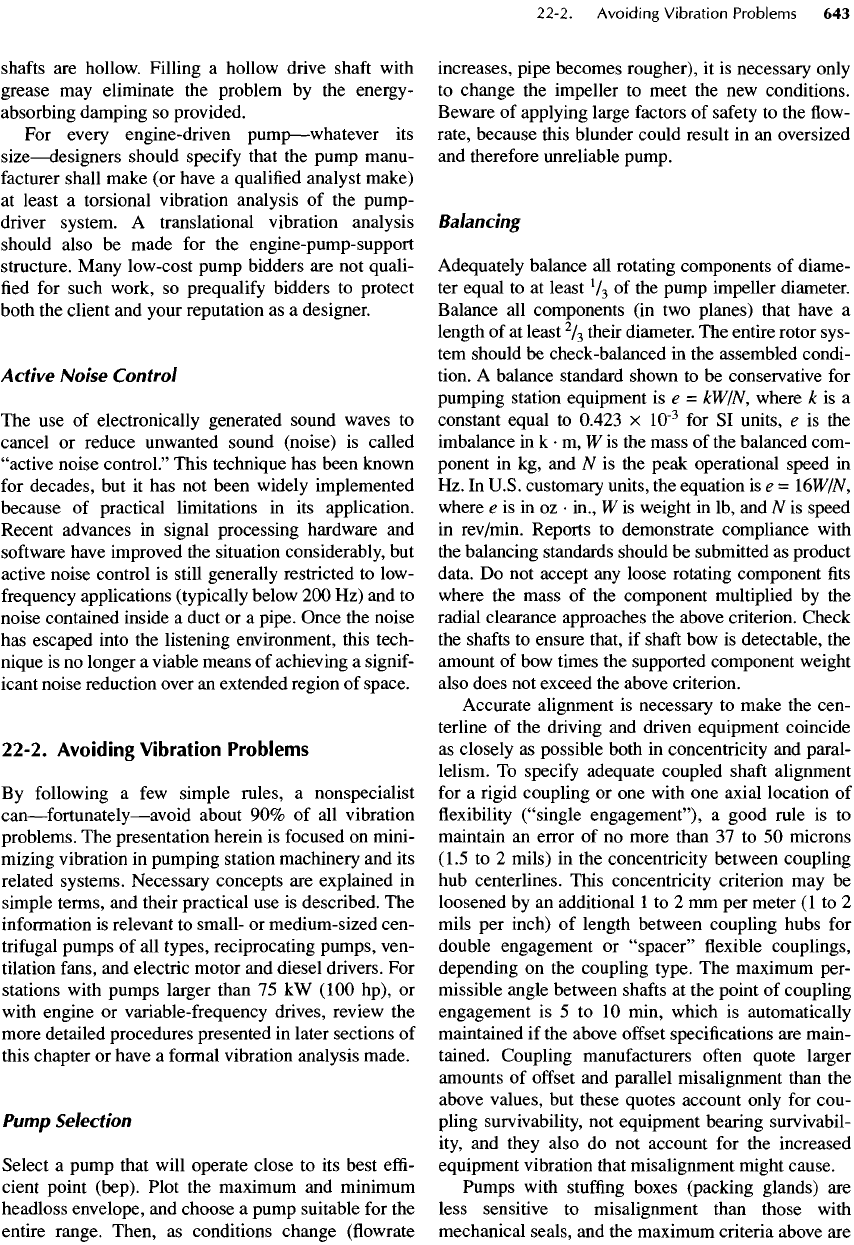
shafts
are
hollow. Filling
a
hollow drive
shaft
with
grease
may
eliminate
the
problem
by the
energy-
absorbing damping
so
provided.
For
every engine-driven
pump
—
whatever
its
size
—
designers
should
specify
that
the
pump manu-
facturer
shall make
(or
have
a
qualified
analyst make)
at
least
a
torsional vibration analysis
of the
pump-
driver system.
A
translational vibration analysis
should also
be
made
for the
engine-pump-support
structure.
Many low-cost pump bidders
are not
quali-
fied
for
such work,
so
prequalify
bidders
to
protect
both
the
client
and
your reputation
as a
designer.
Active
Noise Control
The use of
electronically generated sound waves
to
cancel
or
reduce unwanted sound (noise)
is
called
"active noise
control."
This technique
has
been known
for
decades,
but it has not
been
widely implemented
because
of
practical limitations
in its
application.
Recent advances
in
signal processing hardware
and
software
have improved
the
situation considerably,
but
active
noise control
is
still generally restricted
to
low-
frequency
applications (typically below
200 Hz) and to
noise contained inside
a
duct
or a
pipe. Once
the
noise
has
escaped into
the
listening environment, this tech-
nique
is no
longer
a
viable means
of
achieving
a
signif-
icant
noise reduction over
an
extended region
of
space.
22-2. Avoiding Vibration Problems
By
following
a few
simple rules,
a
nonspecialist
can
—
fortunately
—
avoid
about
90% of all
vibration
problems.
The
presentation
herein
is
focused
on
mini-
mizing
vibration
in
pumping station machinery
and its
related systems. Necessary concepts
are
explained
in
simple terms,
and
their practical
use is
described.
The
information
is
relevant
to
small-
or
medium-
sized
cen-
trifugal
pumps
of all
types, reciprocating pumps, ven-
tilation
fans,
and
electric
motor
and
diesel drivers.
For
stations
with
pumps larger than
75 kW
(100 hp),
or
with
engine
or
variable-frequency drives, review
the
more detailed procedures presented
in
later sections
of
this chapter
or
have
a
formal
vibration analysis made.
Pump
Selection
Select
a
pump
that
will
operate
close
to its
best
effi-
cient point (bep). Plot
the
maximum
and
minimum
headloss envelope,
and
choose
a
pump suitable
for the
entire range. Then,
as
conditions change
(flowrate
increases, pipe becomes rougher),
it is
necessary only
to
change
the
impeller
to
meet
the new
conditions.
Beware
of
applying large factors
of
safety
to the
flow-
rate, because this blunder could result
in an
oversized
and
therefore unreliable pump.
Balancing
Adequately balance
all
rotating components
of
diame-
ter
equal
to at
least
l
/
3
of the
pump impeller diameter.
Balance
all
components
(in two
planes) that have
a
length
of at
least
2
/
3
their diameter.
The
entire rotor sys-
tem
should
be
check-balanced
in the
assembled condi-
tion.
A
balance standard shown
to be
conservative
for
pumping
station equipment
is e =
kW/N,
where
k is a
constant
equal
to
0.423
x
10"
3
for SI
units,
e is the
imbalance
in k •
m,
W is the
mass
of the
balanced com-
ponent
in kg, and
Af
is the
peak operational speed
in
Hz. In
U.S.
customary units,
the
equation
is e =
16W/N,
where
e is in oz •
in.,
W is
weight
in
Ib,
and N is
speed
in
rev/min. Reports
to
demonstrate compliance with
the
balancing standards should
be
submitted
as
product
data.
Do not
accept
any
loose rotating component
fits
where
the
mass
of the
component multiplied
by the
radial clearance approaches
the
above criterion. Check
the
shafts
to
ensure that,
if
shaft
bow is
detectable,
the
amount
of bow
times
the
supported component weight
also
does
not
exceed
the
above criterion.
Accurate alignment
is
necessary
to
make
the
cen-
terline
of the
driving
and
driven equipment
coincide
as
closely
as
possible
both
in
concentricity
and
paral-
lelism.
To
specify
adequate coupled
shaft
alignment
for
a
rigid coupling
or one
with
one
axial location
of
flexibility
("single
engagement"),
a
good rule
is to
maintain
an
error
of no
more than
37 to 50
microns
(1.5
to 2
mils)
in the
concentricity between coupling
hub
centerlines. This concentricity criterion
may be
loosened
by an
additional
1 to 2 mm per
meter
(1
to 2
mils
per
inch)
of
length between coupling hubs
for
double engagement
or
"spacer"
flexible
couplings,
depending
on the
coupling type.
The
maximum per-
missible angle between
shafts
at the
point
of
coupling
engagement
is 5 to 10
min, which
is
automatically
maintained
if the
above
offset
specifications
are
main-
tained. Coupling manufacturers
often
quote larger
amounts
of
offset
and
parallel
misalignment than
the
above values,
but
these quotes account only
for
cou-
pling
survivability,
not
equipment bearing
survivabil-
ity,
and
they also
do not
account
for the
increased
equipment
vibration that misalignment might cause.
Pumps
with
stuffing
boxes (packing glands)
are
less sensitive
to
misalignment than those with
mechanical seals,
and the
maximum
criteria
above
are
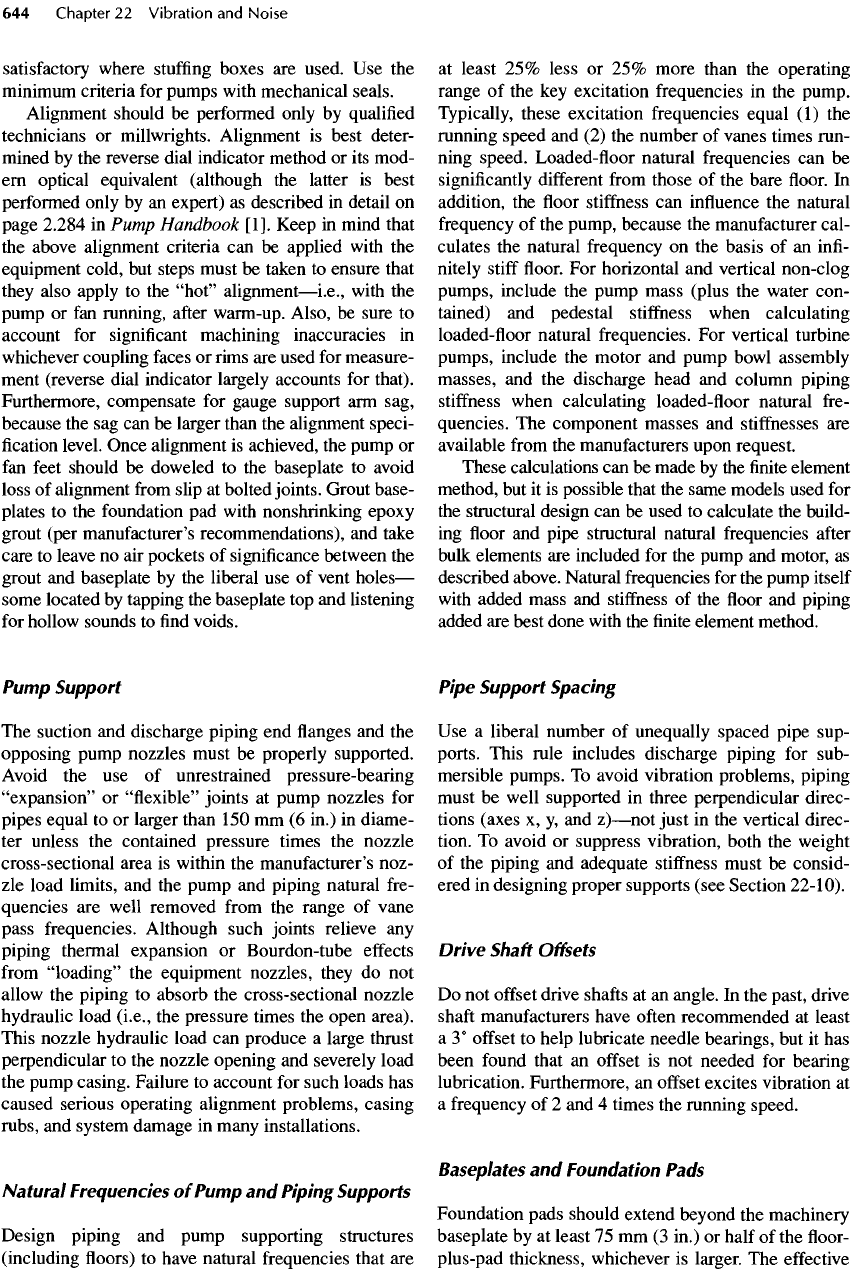
satisfactory
where
stuffing
boxes
are
used.
Use the
minimum
criteria
for
pumps with mechanical
seals.
Alignment
should
be
performed only
by
qualified
technicians
or
millwrights. Alignment
is
best deter-
mined
by the
reverse dial indicator method
or its
mod-
ern
optical equivalent (although
the
latter
is
best
performed
only
by an
expert)
as
described
in
detail
on
page
2.284
in
Pump Handbook
[I].
Keep
in
mind that
the
above alignment criteria
can be
applied with
the
equipment cold,
but
steps must
be
taken
to
ensure that
they
also apply
to the
"hot"
alignment
—
i.e.,
with
the
pump
or fan
running,
after
warm-up. Also,
be
sure
to
account
for
significant
machining inaccuracies
in
whichever
coupling
faces
or rims are
used
for
measure-
ment (reverse dial indicator largely accounts
for
that).
Furthermore, compensate
for
gauge support
arm
sag,
because
the sag can be
larger than
the
alignment
speci-
fication
level. Once alignment
is
achieved,
the
pump
or
fan
feet
should
be
doweled
to the
baseplate
to
avoid
loss
of
alignment
from
slip
at
bolted joints. Grout base-
plates
to the
foundation
pad
with
nonshrinking
epoxy
grout (per manufacturer's recommendations),
and
take
care
to
leave
no air
pockets
of
significance
between
the
grout
and
baseplate
by the
liberal
use of
vent
holes
—
some located
by
tapping
the
baseplate
top and
listening
for
hollow sounds
to find
voids.
Pump
Support
The
suction
and
discharge piping
end flanges and the
opposing pump nozzles must
be
properly supported.
Avoid
the use of
unrestrained pressure-bearing
"expansion"
or
"flexible" joints
at
pump nozzles
for
pipes equal
to or
larger than
150 mm (6
in.)
in
diame-
ter
unless
the
contained pressure times
the
nozzle
cross-sectional area
is
within
the
manufacturer's noz-
zle
load limits,
and the
pump
and
piping natural fre-
quencies
are
well removed
from
the
range
of
vane
pass frequencies. Although such joints relieve
any
piping thermal expansion
or
Bourdon-tube
effects
from
"loading"
the
equipment nozzles, they
do not
allow
the
piping
to
absorb
the
cross-sectional nozzle
hydraulic
load (i.e.,
the
pressure times
the
open area).
This nozzle hydraulic load
can
produce
a
large thrust
perpendicular
to the
nozzle opening
and
severely load
the
pump casing. Failure
to
account
for
such loads
has
caused serious operating alignment problems, casing
rubs,
and
system damage
in
many installations.
Natural
Frequencies
of
Pump
and
Piping
Supports
Design piping
and
pump supporting structures
(including
floors) to
have natural frequencies that
are
at
least
25%
less
or 25%
more than
the
operating
range
of the key
excitation frequencies
in the
pump.
Typically, these excitation frequencies equal
(1) the
running
speed
and (2) the
number
of
vanes times run-
ning speed. Loaded-floor natural frequencies
can be
significantly
different
from
those
of the
bare
floor. In
addition,
the floor
stiffness
can
influence
the
natural
frequency
of the
pump,
because
the
manufacturer cal-
culates
the
natural frequency
on the
basis
of an
infi-
nitely
stiff
floor. For
horizontal
and
vertical non-clog
pumps, include
the
pump mass (plus
the
water con-
tained)
and
pedestal
stiffness
when calculating
loaded-floor
natural frequencies.
For
vertical turbine
pumps, include
the
motor
and
pump bowl assembly
masses,
and the
discharge head
and
column piping
stiffness
when calculating loaded-floor natural fre-
quencies.
The
component
masses
and
stiffnesses
are
available
from
the
manufacturers upon request.
These
calculations
can be
made
by the finite
element
method,
but it is
possible
that
the
same models used
for
the
structural design
can be
used
to
calculate
the
build-
ing floor and
pipe structural natural frequencies
after
bulk
elements
are
included
for the
pump
and
motor,
as
described above. Natural frequencies
for the
pump itself
with
added mass
and
stiffness
of the floor and
piping
added
are
best done with
the finite
element method.
Pipe
Support
Spacing
Use a
liberal
number
of
unequally
spaced
pipe sup-
ports. This rule includes discharge piping
for
sub-
mersible pumps.
To
avoid vibration problems, piping
must
be
well supported
in
three perpendicular direc-
tions (axes
x, y, and
z)
—
not
just
in the
vertical direc-
tion.
To
avoid
or
suppress vibration, both
the
weight
of
the
piping
and
adequate
stiffness
must
be
consid-
ered
in
designing proper supports (see Section 22-10).
DnVe
Shaft
Offsets
Do not
offset
drive
shafts
at an
angle.
In the
past, drive
shaft
manufacturers have
often
recommended
at
least
a 3°
offset
to
help lubricate needle bearings,
but it has
been
found
that
an
offset
is not
needed
for
bearing
lubrication.
Furthermore,
an
offset
excites vibration
at
a
frequency
of 2 and 4
times
the
running speed.
Baseplates
and
Foundation
Pads
Foundation
pads should extend beyond
the
machinery
baseplate
by at
least
75 mm (3
in.)
or
half
of the floor-
plus-pad thickness, whichever
is
larger.
The
effective

thickness
from
subfloor
beams
and
gussets need
not
be
taken into account
in
this calculation.
The
mass
of
machinery
foundations should
be 5 to 10
times that
of
the
machine itself.
The
foundation should have
an
adequate aspect ratio. That
is, the
"footing"
lines
from
the
centerline
of the
pump
inclined
30° to the
vertical
should
pass through
the
bottom
of the
foundation
mass
—
not
through
its
sides.
The
centerline
of the
pump
is
considered
to be at the
center
of the
impeller
hub
except
for
vertical turbines.
Pump
Suction
Piping
If
possible,
use
straight suction piping
up to the
pump
suction
nozzle,
and
keep
any
required bends
in a
sin-
gle
plane.
As a
minimum, avoid piping
reducers
or
bends within
5 to 10
suction pipe diameters
of the
pump
inlet, unless
the
pump
has
been specially
designed
to
accommodate such
fittings
closer
to the
pump
(as in
some vertical nonclog pumps).
If in
doubt,
seek
the
pump manufacturer's advice.
Single
and
Double
Volutes
The
vane passing force
is
generally
2 to 3
times higher
for
single volute pumps than
for
"twin"
or
"double"
volute
pumps. Where practical, choose twin volute
pumps
(preferably with
an odd
number
of
impeller
vanes), because they minimize
the
vane passing force
and
maximize both
bep
and, particularly,
off-design
efficiency.
Single volutes
are
often
necessary because
of
cost
or
solids-passing capability.
The
hydraulic
imbalance present
in
single volutes
is
minimized,
at
some decrease
of
efficiency,
by
increasing
the
clear-
ance between impeller
and
volute tongue.
Pump
Suction Conditions
Ensure
adequate pump suction conditions with
suffi-
cient
NPSH
A
including
all
significant
effects
(see Fig-
ure
10-13)
and a
sump design
in
which surface
and
subsurface
vortices
are
suppressed.
Recommended
Detailed
Design
Practices
The
potential
for
vibration problems
is
often
given
insufficient
attention
at the
beginning
of the
pumping
station
design process.
By
following appropriate
design rules,
and
with
a bit of
luck,
it is
likely that
the
vibrational
behavior
of the
installed equipment will
be
acceptable. However, this
is a
risk
not
worth taking
for
pump
drivers
of
more than
56 kW (75
hp),
and the
cost
to all
parties
in
those situations where vibration
problems
do
occur quickly overshadows
the
"savings"
of
not
performing analyses
and
test procedures such
as
those recommended below.
Controlling
Excitation
Forces
The first
step
in
controlling excitation forces
is to
limit
mechanical operational forces that
can act to
drive
machinery vibration.
The
primary forces that must
be
controlled
are
caused either
by
imbalance
of
large
diameter rotating components such
as
coupling hubs
or
pump
impellers,
or by
misalignment
of
coupled
shafts.
These issues
are
discussed above.
Although
mechanical forces
may be the
most com-
mon
cause
of
excessive
vibration, another common
problem
is the use of a
pipe roughness
coefficient
that
is
too
conservative
and a
resulting
TDH
that
is too
high.
A
pump selected
on
such
a
basis will operate
well
to the
right
of its
bep, will discharge
a
higher
flowrate
than
it
should,
and
will increase
the
hydraulic
excitation forces.
The
motor will draw more current
and may be
overtaxed. Eliminate this problem
by
ensuring
the
proper value
of C is
used
for
selecting
both pump
and
impeller.
The
primary
frequency
of
hydraulic excitations
is
the
vane-passing
frequency.
The
forces
and the
resulting
vibration
depend upon several factors, controllable
at
the
design
and
specification stage.
The
most important
method
of
minimizing vane-passing vibration
is to
design proper suction piping,
to use
double volute
or
centered volute pump designs wherever possible,
and
—
most
important
—
to
operate
the
pump
at or
near
the
bep.
For all
types
of
volutes,
it is
possible
to
lower vane
passing forces
at
some expense
of
efficiency
by
open-
ing up the
clearance between
the
impeller vanes
and
the
volute tongue
or
diffuser
vanes. This opening
is
called
the
"B-Gap."
Designers should,
in
general,
be
wary
of
excessive vane-passing vibrations
from
any
pump
with
a
diametral B-Gap
of
less than
4% of the
impeller diameter,
and a
B-Gap
of 6 to 10% or
more
is
preferable,
although excessive B-Gap
can
encourage
discharge recirculation,
as
discussed below, when
operating below
the
bep.
A
sound approach
is to
fol-
low
manufacturer guidance
on the
setting
of the
B-Gap, while enforcing appropriate vibration
specifi-
cations (discussed below)
and
performance guarantees
throughout
the
operating range.
Reduced
Flow
For all
types
of
centrifugal pumps,
the
vibrations,
shaft
deflections,
and
bearing loads usually increase
as the
pump
is run at
lower
flows.
They
do not
decrease
as is
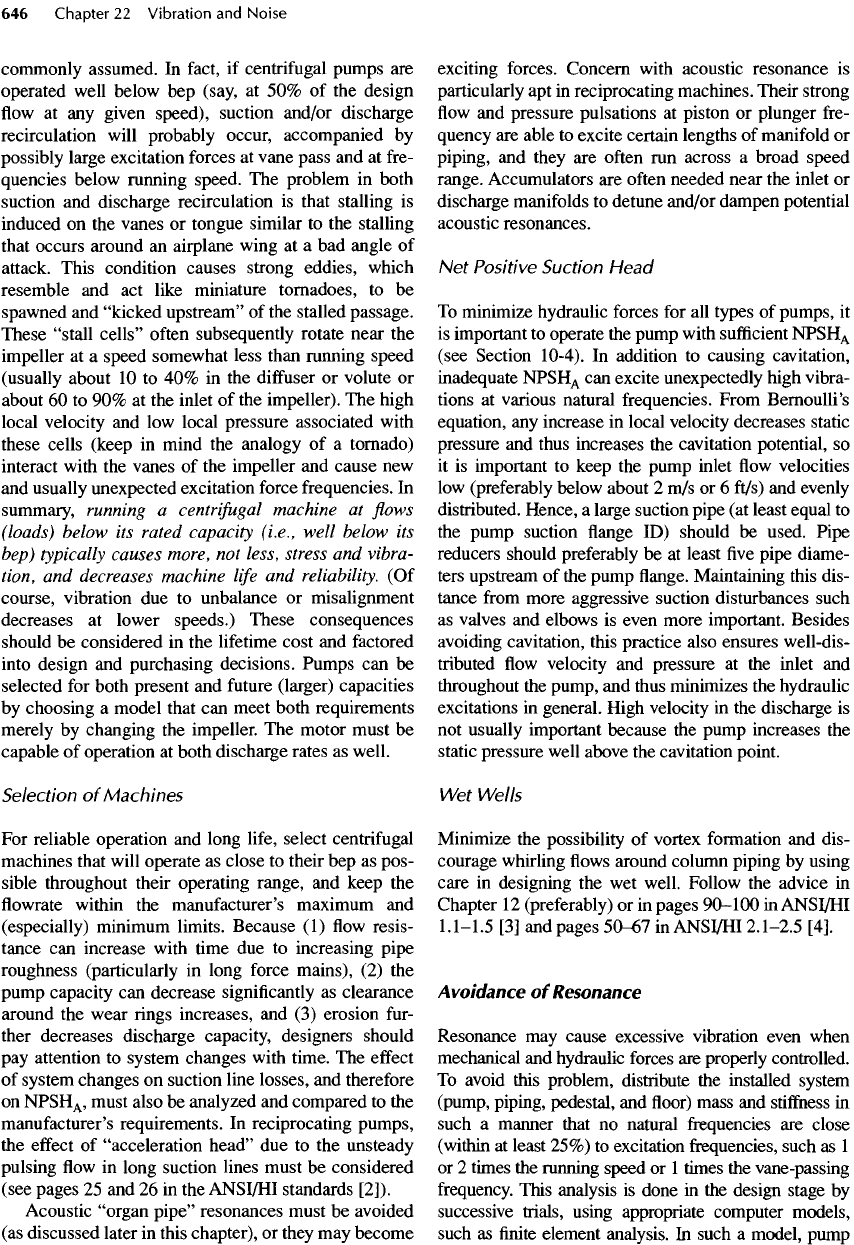
commonly
assumed.
In
fact,
if
centrifugal pumps
are
operated well below
bep
(say,
at 50% of the
design
flow
at
any
given speed), suction and/or discharge
recirculation will probably occur, accompanied
by
possibly large excitation forces
at
vane pass
and at
fre-
quencies below running
speed.
The
problem
in
both
suction
and
discharge recirculation
is
that stalling
is
induced
on the
vanes
or
tongue similar
to the
stalling
that
occurs around
an
airplane wing
at a bad
angle
of
attack. This condition causes strong eddies, which
resemble
and act
like miniature tornadoes,
to be
spawned
and
"kicked
upstream"
of the
stalled passage.
These
"stall
cells"
often
subsequently rotate near
the
impeller
at a
speed somewhat
less
than running speed
(usually
about
10 to 40% in the
diffuser
or
volute
or
about
60 to 90% at the
inlet
of the
impeller).
The
high
local velocity
and low
local pressure associated with
these cells (keep
in
mind
the
analogy
of a
tornado)
interact with
the
vanes
of the
impeller
and
cause
new
and
usually unexpected excitation force frequencies.
In
summary,
running
a
centrifugal
machine
at flows
(loads)
below
its
rated
capacity
(i.e., well below
its
bep)
typically
causes
more,
not
less, stress
and
vibra-
tion,
and
decreases machine
life
and
reliability.
(Of
course, vibration
due to
unbalance
or
misalignment
decreases
at
lower speeds.) These consequences
should
be
considered
in the
lifetime cost
and
factored
into design
and
purchasing decisions. Pumps
can be
selected
for
both present
and
future
(larger) capacities
by
choosing
a
model that
can
meet both requirements
merely
by
changing
the
impeller.
The
motor must
be
capable
of
operation
at
both discharge rates
as
well.
Selection
of
Machines
For
reliable operation
and
long
life,
select centrifugal
machines that will operate
as
close
to
their
bep as
pos-
sible throughout their operating range,
and
keep
the
flowrate
within
the
manufacturer's maximum
and
(especially) minimum limits. Because
(1) flow
resis-
tance
can
increase
with
time
due to
increasing pipe
roughness
(particularly
in
long force mains),
(2) the
pump
capacity
can
decrease
significantly
as
clearance
around
the
wear rings increases,
and (3)
erosion fur-
ther
decreases discharge capacity, designers should
pay
attention
to
system changes
with
time.
The
effect
of
system changes
on
suction line
losses,
and
therefore
on
NPSH
A
,
must also
be
analyzed
and
compared
to the
manufacturer's
requirements.
In
reciprocating pumps,
the
effect
of
"acceleration
head"
due to the
unsteady
pulsing
flow in
long suction lines must
be
considered
(see pages
25 and 26 in the
ANSI/HI
standards
[2]).
Acoustic
"organ
pipe"
resonances must
be
avoided
(as
discussed later
in
this chapter),
or
they
may
become
exciting forces. Concern with acoustic resonance
is
particularly
apt in
reciprocating machines.
Their
strong
flow and
pressure pulsations
at
piston
or
plunger fre-
quency
are
able
to
excite certain lengths
of
manifold
or
piping,
and
they
are
often
run
across
a
broad speed
range. Accumulators
are
often
needed near
the
inlet
or
discharge manifolds
to
detune and/or dampen potential
acoustic
resonances.
Net
Positive
Suction
Head
To
minimize hydraulic forces
for all
types
of
pumps,
it
is
important
to
operate
the
pump with
sufficient
NPSH
A
(see Section
10-4).
In
addition
to
causing cavitation,
inadequate
NPSH
A
can
excite unexpectedly high vibra-
tions
at
various natural frequencies. From Bernoulli's
equation,
any
increase
in
local velocity decreases static
pressure
and
thus increases
the
cavitation potential,
so
it
is
important
to
keep
the
pump inlet
flow
velocities
low
(preferably below about
2
m/s
or 6
ft/s)
and
evenly
distributed. Hence,
a
large suction pipe
(at
least equal
to
the
pump suction
flange ID)
should
be
used. Pipe
reducers should preferably
be at
least
five
pipe diame-
ters upstream
of the
pump
flange.
Maintaining this
dis-
tance
from
more aggressive suction disturbances such
as
valves
and
elbows
is
even more important. Besides
avoiding
cavitation, this practice also ensures well-dis-
tributed
flow
velocity
and
pressure
at the
inlet
and
throughout
the
pump,
and
thus minimizes
the
hydraulic
excitations
in
general.
High velocity
in the
discharge
is
not
usually important because
the
pump increases
the
static
pressure well above
the
cavitation point.
Wet
Wells
Minimize
the
possibility
of
vortex formation
and
dis-
courage whirling
flows
around column piping
by
using
care
in
designing
the wet
well. Follow
the
advice
in
Chapter
12
(preferably)
or in
pages
90-100
in
ANSI/HI
1.1-1.5
[3] and
pages
50-67
in
ANSI/HI
2.1-2.5
[4].
Avoidance
of
Resonance
Resonance
may
cause excessive vibration even when
mechanical
and
hydraulic forces
are
properly controlled.
To
avoid this problem, distribute
the
installed
system
(pump,
piping, pedestal,
and floor)
mass
and
stifrhess
in
such
a
manner that
no
natural frequencies
are
close
(within
at
least 25%)
to
excitation
frequencies,
such
as 1
or
2
times
the
running speed
or 1
times
the
vane-passing
frequency.
This
analysis
is
done
in the
design
stage
by
successive trials, using appropriate computer models,
such
as finite
element analysis.
In
such
a
model, pump
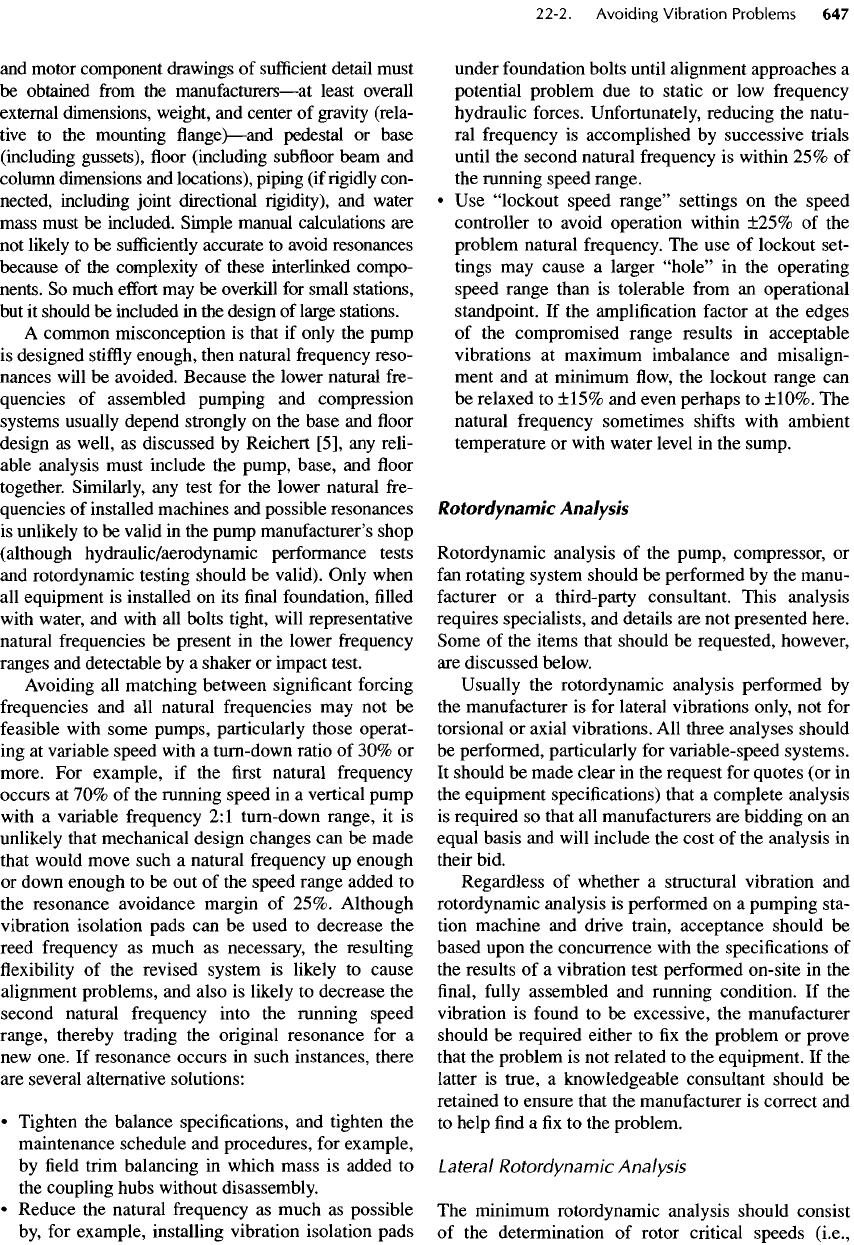
and
motor component drawings
of
sufficient
detail must
be
obtained
from
the
manufacturers
—
at
least overall
external
dimensions, weight,
and
center
of
gravity (rela-
tive
to
the
mounting
flange)
—
and
pedestal
or
base
(including
gussets),
floor
(including
subfloor
beam
and
column
dimensions
and
locations), piping
(if
rigidly con-
nected, including joint directional rigidity),
and
water
mass must
be
included. Simple manual calculations
are
not
likely
to be
sufficiently
accurate
to
avoid resonances
because
of the
complexity
of
these interlinked compo-
nents.
So
much
effort
may be
overkill
for
small stations,
but
it
should
be
included
in the
design
of
large stations.
A
common misconception
is
that
if
only
the
pump
is
designed
stiffly
enough, then natural frequency reso-
nances will
be
avoided. Because
the
lower natural fre-
quencies
of
assembled pumping
and
compression
systems
usually depend strongly
on the
base
and floor
design
as
well,
as
discussed
by
Reichert
[5],
any
reli-
able analysis must include
the
pump, base,
and floor
together. Similarly,
any
test
for the
lower natural fre-
quencies
of
installed machines
and
possible resonances
is
unlikely
to be
valid
in the
pump manufacturer's shop
(although
hydraulic/aerodynamic performance tests
and
rotordynamic testing should
be
valid). Only when
all
equipment
is
installed
on its final
foundation,
filled
with
water,
and
with
all
bolts tight, will representative
natural
frequencies
be
present
in the
lower
frequency
ranges
and
detectable
by a
shaker
or
impact test.
Avoiding
all
matching between
significant
forcing
frequencies
and all
natural frequencies
may not be
feasible
with some pumps, particularly those operat-
ing at
variable speed with
a
turn-down ratio
of 30% or
more.
For
example,
if the first
natural frequency
occurs
at 70% of the
running speed
in a
vertical pump
with
a
variable
frequency
2:1
turn-down range,
it is
unlikely
that mechanical design changes
can be
made
that
would move such
a
natural frequency
up
enough
or
down enough
to be out of the
speed range added
to
the
resonance avoidance margin
of
25%. Although
vibration
isolation pads
can be
used
to
decrease
the
reed
frequency
as
much
as
necessary,
the
resulting
flexibility
of
the
revised system
is
likely
to
cause
alignment
problems,
and
also
is
likely
to
decrease
the
second natural frequency into
the
running speed
range, thereby trading
the
original resonance
for a
new
one.
If
resonance occurs
in
such instances, there
are
several alternative solutions:
•
Tighten
the
balance specifications,
and
tighten
the
maintenance
schedule
and
procedures,
for
example,
by
field
trim balancing
in
which mass
is
added
to
the
coupling hubs without disassembly.
•
Reduce
the
natural
frequency
as
much
as
possible
by,
for
example, installing vibration isolation pads
under foundation bolts until alignment approaches
a
potential problem
due to
static
or low
frequency
hydraulic
forces. Unfortunately, reducing
the
natu-
ral
frequency
is
accomplished
by
successive trials
until
the
second natural
frequency
is
within
25% of
the
running speed range.
• Use
"lockout
speed
range"
settings
on the
speed
controller
to
avoid operation within ±25%
of the
problem natural frequency.
The use of
lockout set-
tings
may
cause
a
larger
"hole"
in the
operating
speed range than
is
tolerable
from
an
operational
standpoint.
If the
amplification factor
at the
edges
of
the
compromised range results
in
acceptable
vibrations
at
maximum imbalance
and
misalign-
ment
and at
minimum
flow, the
lockout range
can
be
relaxed
to
±15%
and
even perhaps
to
±10%.
The
natural
frequency sometimes
shifts
with ambient
temperature
or
with water level
in the
sump.
Rotordynamic
Analysis
Rotordynamic
analysis
of the
pump, compressor,
or
fan
rotating system should
be
performed
by the
manu-
facturer
or a
third-party consultant. This analysis
requires specialists,
and
details
are not
presented here.
Some
of the
items that should
be
requested, however,
are
discussed below.
Usually
the
rotordynamic analysis performed
by
the
manufacturer
is for
lateral vibrations only,
not for
torsional
or
axial vibrations.
All
three analyses should
be
performed, particularly
for
variable-speed systems.
It
should
be
made clear
in the
request
for
quotes
(or in
the
equipment specifications) that
a
complete analysis
is
required
so
that
all
manufacturers
are
bidding
on an
equal basis
and
will include
the
cost
of the
analysis
in
their bid.
Regardless
of
whether
a
structural vibration
and
rotordynamic analysis
is
performed
on a
pumping sta-
tion machine
and
drive train, acceptance should
be
based upon
the
concurrence with
the
specifications
of
the
results
of a
vibration test performed on-site
in the
final,
fully
assembled
and
running condition.
If the
vibration
is
found
to be
excessive,
the
manufacturer
should
be
required either
to fix the
problem
or
prove
that
the
problem
is not
related
to the
equipment.
If the
latter
is
true,
a
knowledgeable consultant should
be
retained
to
ensure that
the
manufacturer
is
correct
and
to
help
find a fix to the
problem.
Lateral
Rotordynamic
Analysis
The
minimum rotordynamic analysis should consist
of
the
determination
of
rotor critical speeds (i.e.,
